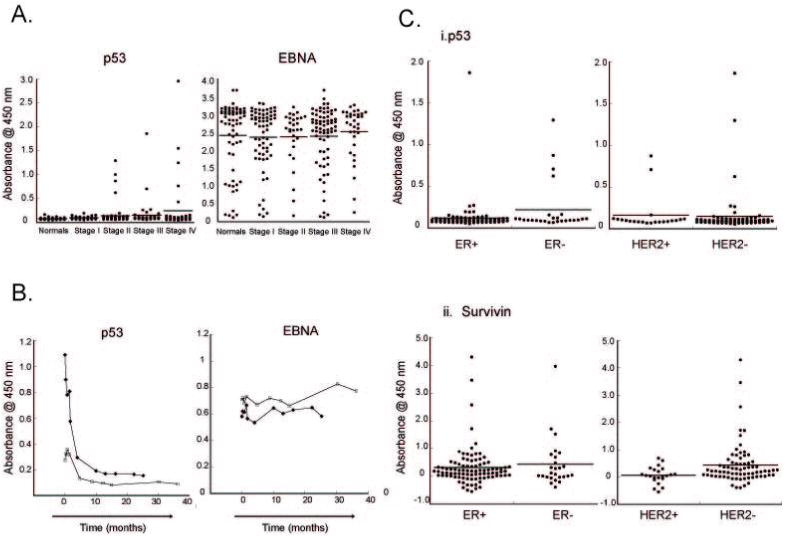Figure 1.

Detection of p53-specific antibodies in early-stage breast cancer. A. Sera derived from breast cancer patients and healthy female donors were tested for p53-specific antibodies (left) and EBNA-1 specific antibodies (right) by protein ELISA. The sera used consisted of normals (n=46); Stage I (n=29); Stage II (n=70); Stage III (n=47) and Stage IV breast cancer (n=40). The median level is shown with a bar. P53 antibody detection correlates with presence of breast cancer (p<0.0001). In contrast, EBNA-1 antibodies are detected at comparable intensity in normals (n=64) and patients (n=132), independent of stage. B. Rapid and durable loss of p53 antibodies with neoadjuvant chemotherapy. Two patients with early-stage Her2+ breast cancer who had detectable antibodies to p53, underwent neoadjuvant chemotherapy treatment with trastuzumab and chemotherapy over a 14-week period. P53 antibodies were detected in serial serum samples by ELISA, and show a rapid loss with the onset of treatment. C. Autoantibodies in breast cancer can be subtype-specific. i) Detection of p53-specific antibodies in breast cancer subtypes. Sera from Figure 1A were divided by tumor subtype. Subgroup analysis showed borderline significant preferential detection of anti-p53 antibodies in patients with ER- (n=26) compared with ER+(n=93) cancer, but no preference between HER2+ (n=22) vs. HER2- (n=73) breast cancer. ii) Selective detection of survivin-specific antibodies in HER2- breast cancer. Sera from the breast cancer patients in (A) were tested for anti-survivin specific antibodies using recombinant GST-tagged survivin. Subgroup analysis showed selective detection of anti-survivin antibodies in patients with HER2- breast cancer, independent of estrogen receptor (ER) status.
